Amirhossein Kazemipour
Stretchable Electrohydraulic Artificial Muscle for Full Motion Ranges in Musculoskeletal Antagonistic Joints
Sep 17, 2024Abstract:Artificial muscles play a crucial role in musculoskeletal robotics and prosthetics to approximate the force-generating functionality of biological muscle. However, current artificial muscle systems are typically limited to either contraction or extension, not both. This limitation hinders the development of fully functional artificial musculoskeletal systems. We address this challenge by introducing an artificial antagonistic muscle system capable of both contraction and extension. Our design integrates non-stretchable electrohydraulic soft actuators (HASELs) with electrostatic clutches within an antagonistic musculoskeletal framework. This configuration enables an antagonistic joint to achieve a full range of motion without displacement loss due to tendon slack. We implement a synchronization method to coordinate muscle and clutch units, ensuring smooth motion profiles and speeds. This approach facilitates seamless transitions between antagonistic muscles at operational frequencies of up to 3.2 Hz. While our prototype utilizes electrohydraulic actuators, this muscle-clutch concept is adaptable to other non-stretchable artificial muscles, such as McKibben actuators, expanding their capability for extension and full range of motion in antagonistic setups. Our design represents a significant advancement in the development of fundamental components for more functional and efficient artificial musculoskeletal systems, bringing their capabilities closer to those of their biological counterparts.
High-Frequency Capacitive Sensing for Electrohydraulic Soft Actuators
Apr 08, 2024Abstract:The need for compliant and proprioceptive actuators has grown more evident in pursuing more adaptable and versatile robotic systems. Hydraulically Amplified Self-Healing Electrostatic (HASEL) actuators offer distinctive advantages with their inherent softness and flexibility, making them promising candidates for various robotic tasks, including delicate interactions with humans and animals, biomimetic locomotion, prosthetics, and exoskeletons. This has resulted in a growing interest in the capacitive self-sensing capabilities of HASEL actuators to create miniature displacement estimation circuitry that does not require external sensors. However, achieving HASEL self-sensing for actuation frequencies above 1 Hz and with miniature high-voltage power supplies has remained limited. In this paper, we introduce the F-HASEL actuator, which adds an additional electrode pair used exclusively for capacitive sensing to a Peano-HASEL actuator. We demonstrate displacement estimation of the F-HASEL during high-frequency actuation up to 20 Hz and during external loading using miniaturized circuitry comprised of low-cost off-the-shelf components and a miniature high-voltage power supply. Finally, we propose a circuitry to estimate the displacement of multiple F-HASELs and demonstrate it in a wearable application to track joint rotations of a virtual reality user in real-time.
Self-Sensing Feedback Control of an Electrohydraulic Robotic Shoulder
Apr 05, 2024Abstract:The human shoulder, with its glenohumeral joint, tendons, ligaments, and muscles, allows for the execution of complex tasks with precision and efficiency. However, current robotic shoulder designs lack the compliance and compactness inherent in their biological counterparts. A major limitation of these designs is their reliance on external sensors like rotary encoders, which restrict mechanical joint design and introduce bulk to the system. To address this constraint, we present a bio-inspired antagonistic robotic shoulder with two degrees of freedom powered by self-sensing hydraulically amplified self-healing electrostatic actuators. Our artificial muscle design decouples the high-voltage electrostatic actuation from the pair of low-voltage self-sensing electrodes. This approach allows for proprioceptive feedback control of trajectories in the task space while eliminating the necessity for any additional sensors. We assess the platform's efficacy by comparing it to a feedback control based on position data provided by a motion capture system. The study demonstrates closed-loop controllable robotic manipulators based on an inherent self-sensing capability of electrohydraulic actuators. The proposed architecture can serve as a basis for complex musculoskeletal joint arrangements.
Real Robot Challenge 2022: Learning Dexterous Manipulation from Offline Data in the Real World
Sep 04, 2023Abstract:Experimentation on real robots is demanding in terms of time and costs. For this reason, a large part of the reinforcement learning (RL) community uses simulators to develop and benchmark algorithms. However, insights gained in simulation do not necessarily translate to real robots, in particular for tasks involving complex interactions with the environment. The Real Robot Challenge 2022 therefore served as a bridge between the RL and robotics communities by allowing participants to experiment remotely with a real robot - as easily as in simulation. In the last years, offline reinforcement learning has matured into a promising paradigm for learning from pre-collected datasets, alleviating the reliance on expensive online interactions. We therefore asked the participants to learn two dexterous manipulation tasks involving pushing, grasping, and in-hand orientation from provided real-robot datasets. An extensive software documentation and an initial stage based on a simulation of the real set-up made the competition particularly accessible. By giving each team plenty of access budget to evaluate their offline-learned policies on a cluster of seven identical real TriFinger platforms, we organized an exciting competition for machine learners and roboticists alike. In this work we state the rules of the competition, present the methods used by the winning teams and compare their results with a benchmark of state-of-the-art offline RL algorithms on the challenge datasets.
Low Voltage Electrohydraulic Actuators for Untethered Robotics
Jun 01, 2023Abstract:Rigid robots can be precise in repetitive tasks but struggle in unstructured environments. Nature's versatility in such environments inspires researchers to develop biomimetic robots that incorporate compliant and contracting artificial muscles. Among the recently proposed artificial muscle technologies, electrohydraulic actuators are promising since they offer comparable performance to mammalian muscles in terms of speed and power density. However, they require high driving voltages and have safety concerns due to exposed electrodes. These high voltages lead to either bulky or inefficient driving electronics that make untethered, high-degree-of-freedom bio-inspired robots difficult to realize. Here, we present low voltage electrohydraulic actuators (LEAs) that match mammalian skeletal muscles in average power density (50.5 W/kg) and peak strain rate (971 percent/s) at a driving voltage of just 1100 V. This driving voltage is approx. 5 - 7 times lower compared to other electrohydraulic actuators using paraelectric dielectrics. Furthermore, LEAs are safe to touch, waterproof, and self-clearing, which makes them easy to implement in wearables and robotics. We characterize, model, and physically validate key performance metrics of the actuator and compare its performance to state-of-the-art electrohydraulic designs. Finally, we demonstrate the utility of our actuators on two muscle-based electrohydraulic robots: an untethered soft robotic swimmer and a robotic gripper. We foresee that LEAs can become a key building block for future highly-biomimetic untethered robots and wearables with many independent artificial muscles such as biomimetic hands, faces, or exoskeletons.
Kinematic Control of Redundant Robots with Online Handling of Variable Generalized Hard Constraints
Feb 26, 2022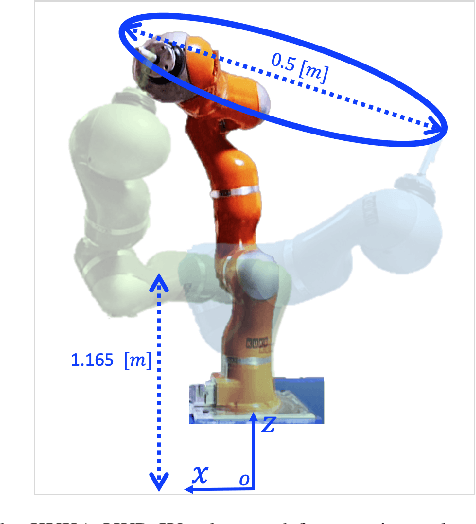
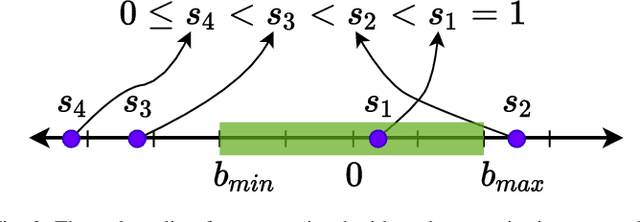
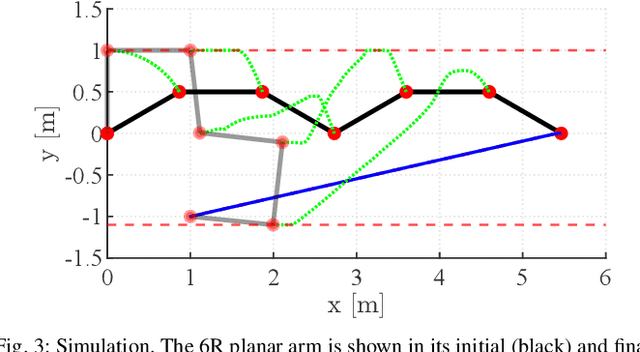
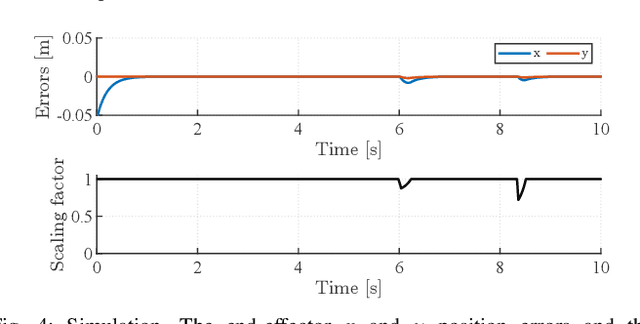
Abstract:We present a generalized version of the Saturation in the Null Space (SNS) algorithm for the task control of redundant robots when hard inequality constraints are simultaneously present both in the joint and in the Cartesian space. These hard bounds should never be violated, are treated equally and in a unified way by the algorithm, and may also be varied, inserted or deleted online. When a joint/Cartesian bound saturates, the robot redundancy is exploited to continue fulfilling the primary task. If no feasible solution exists, an optimal scaling procedure is applied to enforce directional consistency with the original task. Simulation and experimental results on different robotic systems demonstrate the efficiency of the approach. The proposed algorithm can be viewed as a generic platform that is easily applicable to any robotic application in which robots operate in an unstructured environment and online handling of joint and Cartesian constraints is critical.
Dynamic Control of Soft Manipulators to Perform Real-World Tasks
Jan 06, 2022
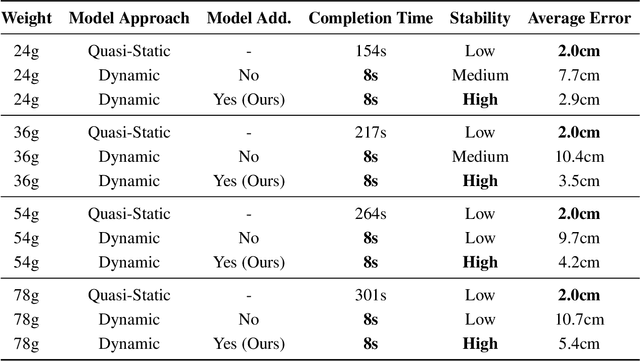
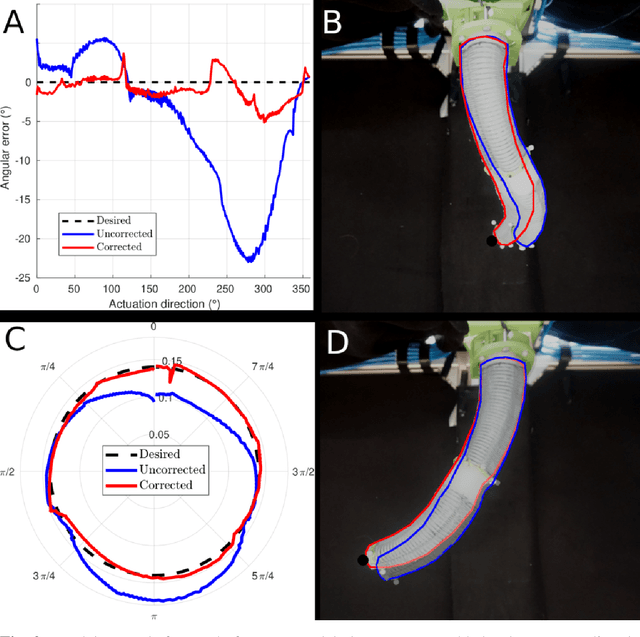
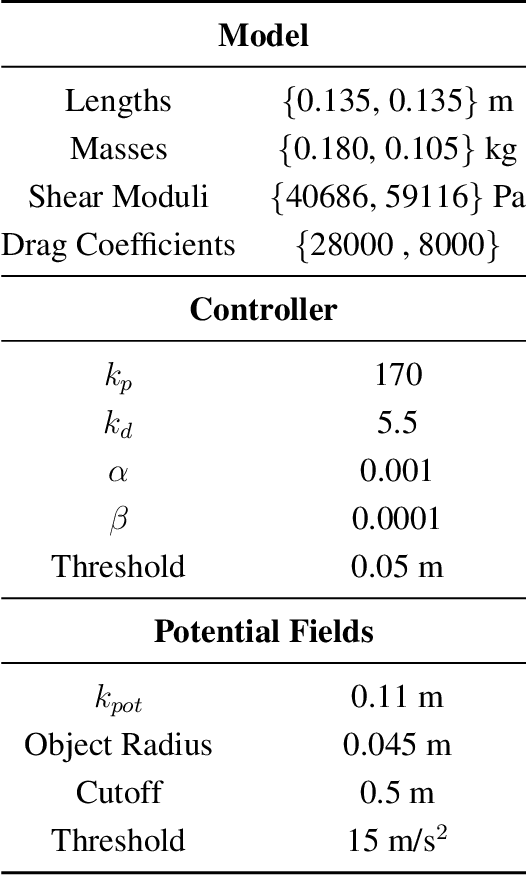
Abstract:Dynamic motions are a key feature of robotic arms, enabling them to perform tasks quickly and efficiently. Soft continuum manipulators do not currently consider dynamic parameters when operating in task space. This shortcoming makes existing soft robots slow and limits their ability to deal with external forces, especially during object manipulation. We address this issue by using dynamic operational space control. Our control approach takes into account the dynamic parameters of the 3D continuum arm and introduces new models that enable multi-segment soft manipulators to operate smoothly in task space. Advanced control methods, previously afforded only to rigid robots, are now adapted to soft robots; for example, potential field avoidance was previously only shown for rigid robots and is now extended to soft robots. Using our approach, a soft manipulator can now achieve a variety of tasks that were previously not possible: we evaluate the manipulator's performance in closed-loop controlled experiments such as pick-and-place, obstacle avoidance, throwing objects using an attached soft gripper, and deliberately applying forces to a surface by drawing with a grasped piece of chalk. Besides the newly enabled skills, our approach improves tracking accuracy by 59% and increases speed by a factor of 19.3 compared to state of the art for task space control. With these newfound abilities, soft robots can start to challenge rigid robots in the field of manipulation. Our inherently safe and compliant soft robot moves the future of robotic manipulation towards a cageless setup where humans and robots work in parallel.
Motion Control of Redundant Robots with Generalised Inequality Constraints
Oct 04, 2021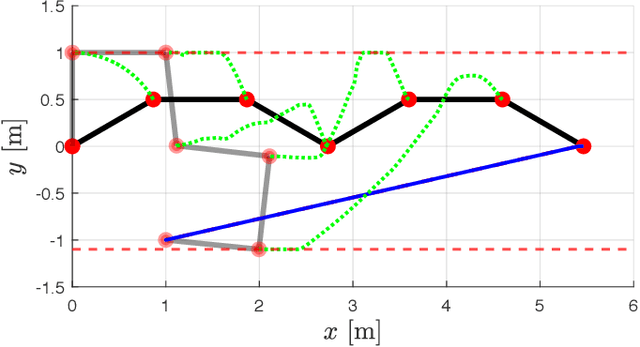
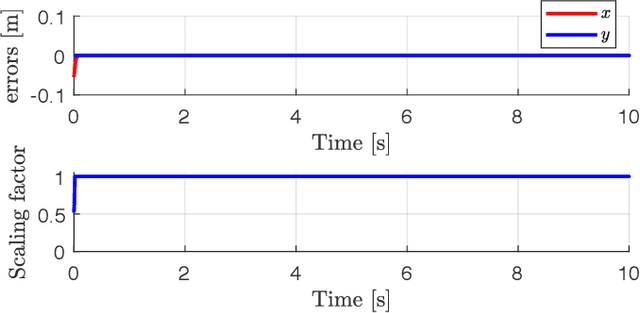
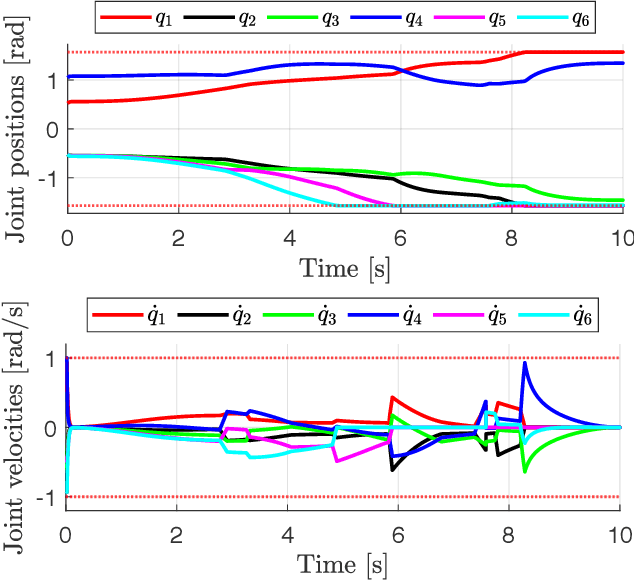
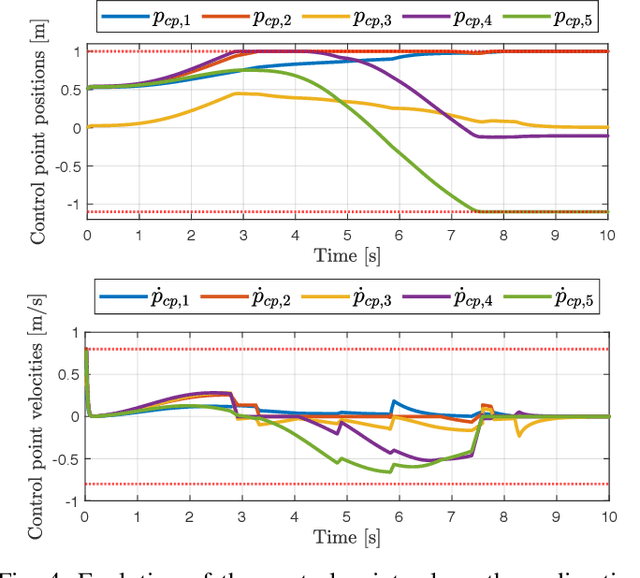
Abstract:We present an improved version of the Saturation in the Null Space (SNS) algorithm for redundancy resolution at the velocity level. In addition to hard bounds on joint space motion, we consider also Cartesian box constraints that cannot be violated at any time. The modified algorithm combines all bounds into a single augmented generalised vector and gives equal, highest priority to all inequality constraints. When needed, feasibility of the original task is enforced by the SNS task scaling procedure. Simulation results are reported for a 6R planar robot.
A Robust Adaptive Approach to Dynamic Control of Soft Continuum Manipulators
Sep 23, 2021
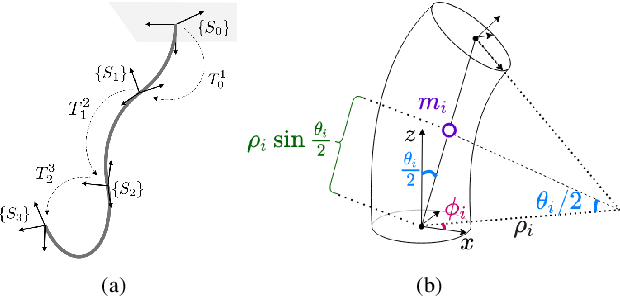


Abstract:Soft robots are made of compliant and deformable materials and can perform tasks challenging for conventional rigid robots. The inherent compliance of soft robots makes them more suitable and adaptable for interactions with humans and the environment. However, this preeminence comes at a cost: their continuum nature makes it challenging to develop robust model-based control strategies. Specifically, an adaptive control approach addressing this challenge has not yet been applied to physical soft robotic arms. This work presents a reformulation of dynamics for a soft continuum manipulator using the Euler-Lagrange method. The proposed model eliminates the simplifying assumption made in previous works and provides a more accurate description of the robot's inertia. Based on our model, we introduce a task-space adaptive control scheme. This controller is robust against model parameter uncertainties and unknown input disturbances. The controller is implemented on a physical soft continuum arm. A series of experiments were carried out to validate the effectiveness of the controller in task-space trajectory tracking under different payloads. The controller outperforms the state-of-the-art method both in terms of accuracy and robustness. Moreover, the proposed model-based control design is flexible and can be generalized to any continuum robotic arm with an arbitrary number of continuum segments.
 Add to Chrome
Add to Chrome Add to Firefox
Add to Firefox Add to Edge
Add to Edge